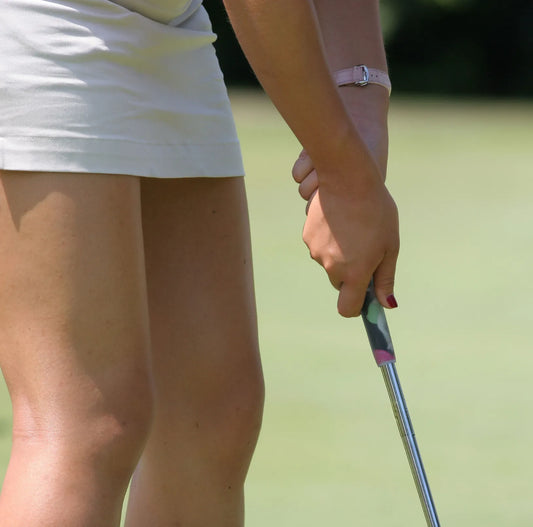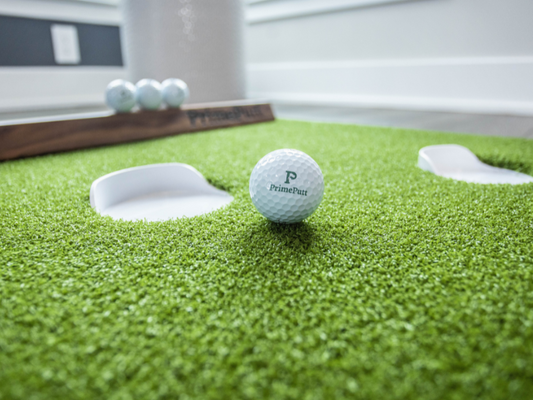All golfers can agree that putting is one of the most important aspects of the game. But even if you practice alignment, posture, and ball positioning, your short game won’t matter unless you have the right putting grip. Like all things in life, and especially golf, there’s no one-size-fits-all solution, and every golfer will favor a different putting grip.
If you want to find the best grip for your swing, the only way to find out is by testing different options and seeing which one feels natural. As you get started, take a look at these common putting grips and tips on how to use them.
The Bottom Line:
- The most common types of putting grips: Interlocking, reverse overlap grip, left-hand low grip style, claw grip style, prayer grip style, and arm lock grip.
- The importance of putter grip size: A thicker grip can help with accuracy, whereas a smaller grip can be beneficial for those who like to feel the smaller muscles in their fingers and hands while they putt.
- Which style will work best? The one that’s most comfortable and keeps both hands, shoulders, and the putter moving together as a singular unit.
- Practices to improve your putting grip: Once you’ve found the right style for you, try an indoor putting mat, grip strengthening exercises, and practice drills to get the most control over your stroke.
The Most Common Types of Putting Grips
It's important to note that these grip overviews are written from the perspective of right-handed golfers. Sorry, lefties! If you are left-handed, don't stop reading; just switch the hands mentioned in the directions. Some styles are considered more conventional than others. While trying each different approach, it is essential to keep your grip pressure consistent and, as the old golf adage goes, "like a firm handshake."
While testing out which golf grip is the right one for you, practice both long and short putts. Keep in mind that most clutch putters keep the butt end of the putter grip at their belly button or slightly forward and try to roll the golf ball off the putter face rather than hit it.
Please keep in mind that slight variations in each of the six putting grip styles can make a massive difference in the feel and efficiency of each grip.
Interlocking Putting Grip Style
- PGA Tour Pros who use this style: Jack Nicklaus and Steve Stricker.
- What does this grip look like? The right hand's pinky finger is "interlocked" between the index and middle fingers of the left hand. The right index finger may also rest comfortably against the putter grip. The putter grip rests mainly on the fingers of both hands.
- Who should think about using this style? Golfers with slightly smaller hands will find this grip most comfortable. An interlocking grip style will feel different if you're putting with a thicker putter grip vs. a thinner putter grip. Many golfers use an interlocking grip as their full swing grip, so, for simplicity's sake, using it in putting makes sense, leaving room for fewer complications. Keep in mind the right wrist can become more activated on longer putts while using this grip style.
Reverse Overlap Grip Style (or the Conventional Putting Grip)
- PGA Tour Pros who use this style: Tiger Woods and Rory McIlroy.
- What does this grip look like? The left index finger is on top of the right pinky finger. Other than that, it is the same grip as the traditional overlap grip style. In this grip, the club runs down the palms rather than the fingers. Tiger has said the "best part of the grip is the unity it brings to both hands."
- Who should think about using this style? The reverse overlap grip style works well with golfers with thicker grips on their putters. This style helps keep the grip primarily in the palms of your hands and prevents any rolling of the hands or arms for a better feel of the putter club face as it squares through impact. It also helps keep your left wrist perfectly aligned with your intended target.
Left Hand Low Grip Style (or the Cross-Handed Grip)
- PGA Tour Pros who use this style: Jordan Speith and Dustin Johnson.
- What does this grip look like? As the name alludes, your left hand is lower than your right hand on the putter grip. Your left forearm is pointed at your right forearm, resting the grip under your left palm pad. (The putter shaft should feel like an extension of your left arm). Your left wrist is pointed at your target. Make sure that the putter shaft leans slightly forward at the address so it can return that way!
- Who should think about using this style? Golfers who want the left shoulder leading the putt. A "flippy" right hand will become non-existent while using this grip. It limits the wrist hinge and keeps the putter handle more square at impact. Many golfers initially find this grip style helps keep short putts in line, but it will likely take some practice and repetition to adjust to longer putts. This type of grip corresponds well with thicker putter grips as the combination helps keep wrists steady throughout the stroke.
Claw Grip Style
- PGA Tour Pros who use this style: Many professionals like Phil Mickelson use this grip style to practice, while a number of European Tour players use it in competition, like Sergio Garcia, Lee Westwood, and Justin Rose.
- What does this grip look like? First, grip the putter with your left hand, your thumb pointing down the shaft and your left hand near the butt end of the club. Take your right hand and create space between your thumb and pointer finger. Point the hand at the ground. Now, place your right hand on the putter's grip in the area between your thumb and pointer finger. You'll want a clear picture of this grip before testing it out!
- Who should think about using this style? A golfer who primarily putts on faster greens. Though this grip isn’t very popular among amateur golfers, it’s another alternative for anyone whose wrists get “flippy” during the putting stroke. This grip almost entirely takes the right hand out of the putting stroke and helps golfers rely more on their shoulders as the primary source of distance and control. The Claw is a more advanced grip to master, and it will take significant time to make the switch. It is an alternative to a conventional putting grip, but it helps the face of the putter stay square through the stroke.
Prayer Grip Style (or the Palm-Facing Grip)
- PGA Tour Pros who use this style: Matt Wallace
- What does this grip look like? There is no dominant hand in this grip style. Your hands are about halfway down the grip of your putter, unlike some other grip styles, which start closer to the butt end of the club. Your hands and palms face each other as if you are praying. There are many variations of where the fingers are placed in this grip. Some golfers have their index fingers on the shaft, and some have their left index fingers curled around the back of the grip.
- Who should think about using this style? It would be best if you had a thicker grip on your putter to use this putting grip effectively, as a thinner grip doesn't allow enough surface area. Also, a golfer with bigger hands might find this putting grip easier than someone with smaller hands. It forces the golfer to grip the club looser in comparison to the other styles and with the hands facing each other. The Prayer Grip creates a triangle with the shoulders to help take the hands out of the putting stroke.
Arm Lock Grip Putting Method
- PGA Tour Pros who use this style: Bryson DeChambeau and Matt Kuchar.
- What does this grip look like? The butt of the putter needs to be about 2 inches below your left elbow, with the left forearm pressed against the putter. The putter remains against the forearm for the entire putting stroke, but this method has many variations of hand and finger placement.
- Who should think about using this style? Anyone who has the length of putter that this grip needs! A standard putter is between 34-36 inches long, while the length of putter needed for this grip style is closer to 40-42 inches. The loft on the putter is also higher to compensate for the forward press required to lean the putter grip into your left arm. This unorthodox arm lock method can be too rigid or different from conventional grip feels for some as it takes the sense of feeling out of the putting stroke.
- It's essential to refrain from anchoring the putter with this method, as that became illegal in 2016. The parallel lean of the putter grip against your forearm, for now, is considered legal.
The Importance of Putter Grip Size
The actual grip on the putter itself can affect the feel of each hand grip style we included above. With so many different grip options to have on your club, it’s important to think about how different grip sizes could enhance your putting game.
For example, a thicker putting grip can help with accuracy and smooth out the putting stroke by forcing the hands into a more neutral position. The maximum diameter of the thickest putter grip the USGA allows is 1.75 inches. It is a good idea to work with a trusted golf professional with a grip removal tool, grip tape, adhesive solution, and a variety of thicker and thinner grips to try out before committing.
A thinner grip is more beneficial to the golfer who likes to feel the smaller muscles in their fingers and hands while they putt. Most golfers with a higher handicap would do better with a more oversized putting grip since a common putting stroke mistake is to "flip" the wrists while putting. This can cause inconsistent distance control and a breakdown in putting technique. Many of the grip styles we covered were created to produce a "quieter" right hand. If the right hand "flips" during the putt, it can change the loft of the putter itself, making it hard to control speed and direction.
Which Style Will Work Best?
Just like selecting a putter head or finding the right club length, a golfer’s putting grip is completely up to the individual! You want to look for the grip style that feels most comfortable and athletic while keeping both hands, shoulders, and the putter moving together as a singular unit. At your next putting practice, give each putting grip style a try.
Which one helps you produce a smooth, solid roll off the putter face? Which feels the most natural? Trust what you feel. As the philosopher Rumi once said, "There is a voice that doesn't use words. Listen." This change could be the catalyst that helps you drop your handicap next golf season!
5 Practices to Improve Your Putting Grip
To get the most consistency and accuracy out of your putting grip, work on your technique to build a strong foundation. Here are some drills and tips to help you improve your putting grip:
Indoor Putting Mat Practice
With the help of an indoor putting mat, you can practice your short game and refine your putting grip anywhere, whether at home or in the office. These putting greens make it easy to maximize your practice time and get comfortable with your grip without heading to the course. The best putting mats resemble the feel of a true green, allowing the ball to naturally roll as if you were putting on the real thing.
Grip Strengthening Exercises
Regardless of which grip you choose, having control over your stroke is essential. Grip-strengthening exercises are a great way to improve control, so here are a few practices to integrate into your training:
- Grip squeezes: Use a metal hand grip strengthener or stress ball and squeeze it with your palms and fingers. Repeat this exercise at least ten times with each hand.
- Wrist curls: Hold a light dumbbell in each hand with your palms facing up. Curl the weights toward your forearm while keeping your elbows still. Use a weight you’re comfortable curling for at least 10 to 15 reps, two to three sets each.
- Reverse wrist curls: Repeat the wrist curls drill, but position your palms so they face down.
Gate Drill
When you begin to get comfortable with your putting grip, start practicing your alignment to make accurate shots. You can try the gate drill, which requires two tees. Place them about the width of your putter head and create a gate for the putter to pass through. Next, put a golf ball three to four feet away from the tees and try to make your putts while keeping your putter head within the gate. Keep repeating this drill to improve face control and alignment.
Ladder Drill
The ladder drill helps you improve distance control, which will require some practice as you get acclimated to your putting grip. To get started, place five golf balls at increasing distances from the hole, starting at three feet and moving out to fifteen. Putt each ball into the hole, starting with the smallest distance, and focus on maintaining a consistent tempo. Pay attention to your stroke length and how it changes based on how far away you are from the hole.
String Line Drill
The string line drill helps you improve accuracy and consistency, similar to the gate drill. To begin, tie a long piece of string to two tees. Stretch the line above your intended putting line or the type of shot you want to practice. If you’re on sloped ground, you can add more tees and form them to mimic a curved shot. Keep your putting grip the same throughout your shots, and try to follow the target line during your stroke.
Our Final Thoughts
If you want to improve your putting game, try out different putting grips and discover which style is best for you. There is no rule saying that your full golf swing grip needs to be the same as the putting grip. Switch it up if that's what feels most comfortable. Being open-minded and willing to experiment with different putting grips may help you control your speed on longer distance putts, keep your putter face square through the impact zone, or both.
The off-season is the perfect time of year to make a grip change. When the flat stick makes up about 40% of your total scores, it's definitely worth the trial and error period to find the putting grip that fills you with the most confidence and makes way for you to sink more putts.





